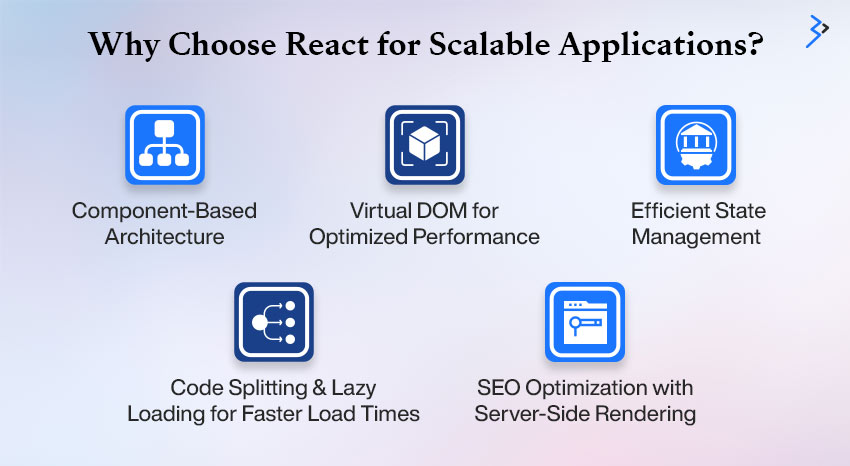Scalability is a crucial factor in modern web application development. As businesses grow, their digital presence must keep up with increasing user demands, ensuring seamless performance and reliability. React, one of the most popular JavaScript libraries is a go-to choice for building dynamic front-end applications. When combined with Microsoft Azure’s robust cloud services, businesses can quickly achieve scalable, high-performing web applications.
This article explores integrating React applications with Azure services like Microsoft Azure Cloud Service and Azure Storage, optimizing deployment pipelines, and efficiently managing application states. We will also discuss best practices and strategies for building scalable front-end applications using these technologies.
Why Choose React for Scalable Applications?

React’s widespread popularity is no coincidence. According to the latest Stack Overflow Developer Survey, React consistently ranks among the most popular front-end libraries. Its ability to create dynamic, high-performance applications has made it the go-to choice for startups and industry giants. Companies like Airbnb, Uber, Netflix, Instagram, PayPal, Facebook, and Dropbox rely on React to deliver seamless and scalable user experiences.
So, what makes React ideal for building scalable applications? Let’s explore the key advantages:
1. Component-Based Architecture
One of React’s core strengths is its component-based architecture, which allows developers to break down the UI into modular, reusable components. This approach simplifies:
- Code Maintenance: Instead of modifying a massive codebase, developers can update individual components, making the application easier to scale.
- Collaboration: Teams can work on separate components independently, speeding up development and improving efficiency.
- Reusability: Components can be reused across different parts of an application or even across multiple projects, reducing redundancy and development effort.
This modularity makes React an excellent choice for applications that must grow and evolve without becoming unmanageable.
2. Virtual DOM for Optimized Performance
React’s Virtual DOM (VDOM) ensures that applications remain highly responsive, even as they scale. Instead of updating the entire UI whenever there’s a change, React:
- Creates a lightweight copy of the real DOM (Virtual DOM)
- Only identifies the parts of the UI that need to be updated
- Efficiently updates those specific parts without re-rendering the entire page.
This approach significantly boosts performance, making React suitable for applications with frequent UI updates, such as real-time dashboards, chat applications, and social media feeds.

3. Efficient State Management
As applications grow, managing their state (data that changes over time) becomes increasingly complex. React provides powerful tools for handling state efficiently:
- React’s built-in state management using the estate and seducer hooks works well for small to medium applications.
- External state management libraries like Redux, Recoil, Zustand, and MobX provide structured ways to handle complex data flows, ensuring that:
- Data updates are predictable and centralized.
- Components only re-render when necessary, reducing performance overhead.
- The application-wide state is easily manageable, preventing inconsistencies.
These state management solutions ensure smooth performance and maintainability for large-scale applications with multiple data sources and frequent updates.
4. Code Splitting & Lazy Loading for Faster Load Times
Scalability isn’t just about handling large amounts of data and optimizing user performance. React supports code splitting and lazy loading, which help improve application speed by:
- Loading only the essential code when needed rather than loading everything simultaneously.
- Reducing initial page load times, enhancing user experience.
- Optimizing bundle sizes, preventing performance degradation in large applications.
By integrating React.lazy() and React Suspense, developers can defer loading non-essential components until required, making applications more responsive and efficient.
5. SEO Optimization with Server-Side Rendering (SSR)
While traditional React applications rely on client-side rendering (CSR), frameworks like Next.js enable Server-Side Rendering (SSR), which helps improve SEO and page speed.
Its benefits include:
- Better Search Engine Rankings: Search engines can index fully-rendered pages, improving visibility.
- Faster Time-to-Interactive (TTI): Content loads quickly, reducing bounce rates.
- Improved User Experience: Users get instant access to content rather than waiting for JavaScript to load.
For businesses that rely on organic traffic, React with Next.js ensures that applications remain scalable and discoverable by search engines.
Read More – Next.js vs. React: An In-Depth Comparison for Modern Web Development
Integrating React with Azure for Scalability

Azure provides a suite of cloud services complementing React applications, enabling seamless scalability and efficient resource management. Here’s how different Azure services enhance React-based applications:
1. Hosting React Apps with Azure App Service
Azure App Service offers a fully managed platform for hosting React applications. It supports automatic scaling, high availability, and security, making it a preferred choice for production applications.
Key Benefits:
- Automatic Scaling: Adjusts the number of instances based on traffic load, ensuring optimal performance.
- Continuous Deployment: Supports CI/CD pipelines with GitHub Actions, Azure DevOps, and Bitbucket.
- Global Reach: Deploy applications in multiple Azure regions to serve users worldwide with minimal latency.
2. Efficient Storage Management with Azure Storage
React applications often require efficient data storage solutions for handling assets, user-generated content, and static files. Azure Storage provides:
- Blob Storage: For storing images, videos, and other unstructured data.
- Table Storage: A NoSQL data store for fast and scalable data retrieval.
- Queue Storage: Helps in asynchronous messaging between application components for better scalability.
3. Optimizing State Management with Azure Cosmos DB
Azure Cosmos DB is a globally distributed, multi-model database designed for scalability and high availability. React applications can leverage Cosmos DB for:
- Real-Time Data Updates: Ideal for chat applications, dashboards, and collaborative tools.
- Automatic Scaling: Adjusts performance and storage based on demand.
- Seamless Integration: Works well with React state management libraries like Redux and Recoil.
4. Enhancing Performance with Azure Functions
Azure Functions is a serverless computing service that enables developers to run event-driven code without managing infrastructure. It helps React applications scale efficiently by:
- Handling Background Tasks: Offloads processing-intensive tasks like image processing and data transformations.
- Integrating with APIs: Acts as a backend API for React applications.
- Auto-Scaling: Dynamically scales based on request volume.
Read More – A Comprehensive Guide to React vs React Native
Best Practices for Building Scalable React Applications with Azure

1. Implement a Component-Based Architecture
Breaking down the UI into reusable components ensures better code management and scalability. Following a single-responsibility principle for components leads to improved maintainability.
2. Use Effective State Management
Choosing the proper state management library (Redux, MobX, Recoil) helps maintain consistency across application components. Using Context API for smaller applications also simplifies state management.
3. Optimize Performance with Code Splitting and Lazy Loading
Large React applications can slow down due to excessive JavaScript bundles. Implementing lazy loading using React. Lazy and React. Suspense can significantly improve load times.
const LazyComponent = React.lazy(() => import(‘./LazyComponent’));
Function App() {
return (
<React.Suspense fallback={<div>Loading…</div>}>
<LazyComponent />
</React.Suspense>
);
}
4. Leverage Server-Side Rendering (SSR) with Next.js
Next.js, a React framework, enhances scalability by enabling server-side rendering (SSR) and static site generation (SSG). This results in faster load times and better SEO performance.
5. Secure Applications with Azure Security Best Practices
Security is critical when deploying applications at scale. Follow these Azure security best practices:
- Use Managed Identities: Reduce dependency on hardcoded credentials.
- Implement Azure Application Gateway: Secure applications with web firewalls (WAFs).
- Enable Multi-Factor Authentication (MFA): Protect user accounts from unauthorized access.
6. Automate Deployment with Azure DevOps
CI/CD pipelines automate the build, testing, and deployment process, reducing human errors and ensuring seamless updates. Azure DevOps integrates with GitHub, enabling automated deployments.
7. Monitor and Scale Efficiently
Monitoring application performance and scaling automatically is crucial for maintaining a responsive user experience. Use:
- Azure Monitor: Tracks application health and performance metrics.
- Application Insights: Detects bottlenecks and enhances debugging.
- Autoscaling Policies: Automatically adjusts resources based on real-time traffic patterns.
Read More – Building Your First React Native App: A Step-by-Step Guide
Case Study: Scaling a React-based E-Commerce Platform with Azure
Overview
A leading e-commerce business faced significant challenges scaling its front-end application to handle millions of daily transactions. As customer demand grew, the platform needed to ensure high availability, seamless performance, and cost efficiency without compromising the user experience.
By integrating React with Azure, the company achieved unparalleled scalability, reduced infrastructure costs, and improved performance, resulting in a superior shopping experience for customers worldwide.
Challenges Faced
- Performance Bottlenecks: Slow page load times, especially during high-traffic sales events.
- Scalability Issues: The previous infrastructure struggled to handle spikes in user traffic.
- High Operational Costs: Rising server costs due to inefficient resource allocation.
- Data Consistency: Managing real-time order updates and inventory synchronization across multiple regions.
Solution: Leveraging React & Azure for Scalable Architecture
To overcome these challenges, the e-commerce business integrated React with Microsoft Azure, utilizing a suite of cloud services designed for performance, scalability, and cost optimization.
Here’s how the architecture was optimized:
1. Azure App Service for Scalable Front-End Hosting
- Why? Provided an easily scalable, managed hosting solution for the React front-end.
- Impact: Automatically handled traffic spikes, ensuring smooth performance during flash sales and seasonal peaks.
2. Azure Cosmos DB for High-Speed, Reliable Database Access
- Why? A globally distributed NoSQL database optimized for low latency and high availability.
- Impact: Enabled real-time synchronization of product availability, pricing updates, and customer orders.
3. Azure Functions for Efficient Backend Processing
- Why? A serverless computing service that executed critical tasks like order confirmations, payment processing, and inventory updates without dedicated server management.
- Impact: Reduced backend server costs by 50% and improved transaction processing speed.
4. Azure Content Delivery Network (CDN) for Faster Load Times
- Why? Ensured static assets (images, scripts, stylesheets) were delivered efficiently to users across different geographic locations.
- Impact: Achieved a 30% improvement in page load speeds, reducing bounce rates and enhancing user engagement.
5. Auto-Scaling and Load Balancing for Seamless Performance
- Why? Ensured application performance remained optimal, even under unpredictable user traffic.
- Impact: Achieved 99.99% uptime, maintaining a flawless shopping experience.
Results & Business Impact
By implementing these solutions, the e-commerce platform achieved:
1. 30% Faster Page Load Speeds – Enhanced user experience and increased conversions
2. 50% Reduction in Server Costs – Optimized resource allocation, cutting unnecessary expenses.
3. 99.99% Uptime – Ensured uninterrupted access to the platform, even during high-traffic events.
4. Seamless Scalability – The ability to handle millions of daily transactions without performance degradation.
Conclusion
Building scalable front-end applications with React and Azure is a strategic choice for businesses seeking high performance, reliability, and cost efficiency.
By leveraging Azure’s cloud infrastructure, auto-scaling capabilities, and serverless computing, businesses can scale React applications effortlessly while maintaining a secure and efficient digital experience.
Ready to scale your React application?
Partner with Brainvire, and let’s build future-ready digital solutions that drive growth and innovation!
Related Articles
-
Boosting App Performance: Top React Native Optimization Strategies
Improving app performance is essential to providing a smooth user experience, and React Native is a notable mobile development framework. This post examines excellent optimization techniques to improve the performance
-
Building Cross-Platform Mobile Apps with React Native: A Complete Guide
Think about the last time you downloaded an app. Was it built for iOS or Android? Probably not. Users expect seamless experiences regardless of their device, and that’s precisely where
-
Building Your First React Native App: A Step-by-Step Guide
It’s a thrilling trip to start developing your first React Native application. This detailed guide is intended to serve as your compass, guiding you through the procedure in an understandable




